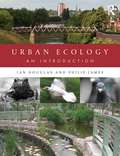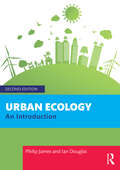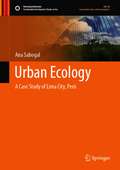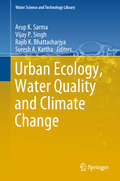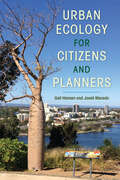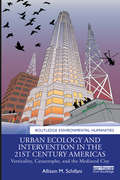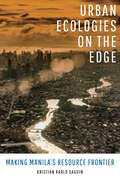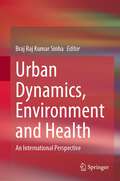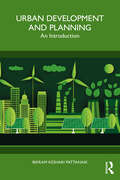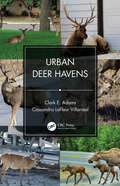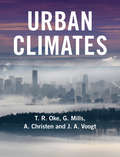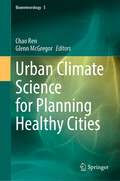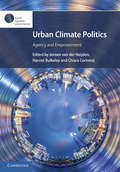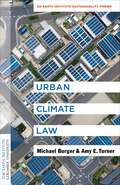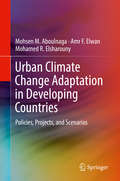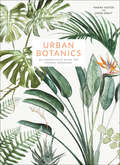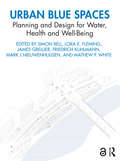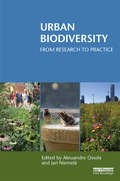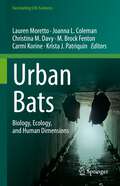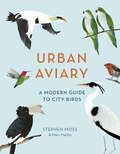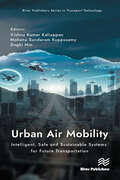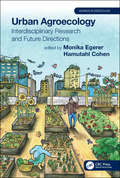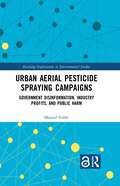- Table View
- List View
Urban Ecology: An Introduction
by Ian Douglas Philip JamesUrban Ecology: An Introduction seeks to open the reader’s mind and eyes to the way in which nature permeates everyday urban living, and how it has to be understood, cared for, and managed in order to make our towns and cities healthier places to visit and in which to live and work. The authors examine how nature can improve our physical and mental health, the air we breathe and the waters we use, as well as boosting our enjoyment of parks and gardens. Urban Ecology sets out the science that underlies the changing natural scene and the tools used to ensure that cities become both capable of adapting to climate change and more beautiful and resilient. The book begins with a discussion of the nature of urban places and the role of nature in towns and cities. Part 1 looks at the context and content of urban ecology, its relationship to other foci of interest within ecology and other environmental sciences, and the character of city landscapes and ecosystems. In Part 2 the authors set out the physical and chemical components of urban ecosystems and ecological processes, including urban weather and climate, urban geomorphology and soils, urban hydrology and urban biogeochemical cycles. In Part 3 urban habitats, urban flora and fauna, and the effects of, deliberate and inadvertent human action on urban biota are examined. Part 4 contains an exploration of the identification and assessment of ecosystem services in urban areas, emphasising economic evaluation, the importance of urban nature for human health and well-being, and restoration ecology and creative conservation. Finally, in Part 5 the tasks for urban ecologists in optimising and sustaining urban ecosystems, providing for nature in cities, adapting to climate change and in developing the urban future in a more sustainable manner are set out. Within the 16 chapters of the book – in which examples from around the world are drawn upon - the authors explore current practice and future alternatives, set out procedures for ecological assessment and evaluation, suggest student activities and discussion topics, provide recommended reading and an extensive bibliography. The book contains more than 150 tables and over 150 photographs and diagrams.
Urban Ecology: An Introduction
by Ian Douglas Philip JamesThis fully revised second edition reflects the great expansion in urban ecology research, action, and teaching since 2015. Urban ecology provides an understanding of urban ecosystems and uses nature-based techniques to enhance habitats and alleviate poor environmental conditions. Already the home to the majority of the world’s people, urban areas continue to grow, causing ecological changes throughout the world. To help students of all professions caring for urban areas and the people, animals, and plants that live in them, the authors set out the environmental and ecological science of cities, linkages between urban nature and human health, urban food production in cities, and how we can value urban nature. The authors explore our responsibilities for urban nature and greening, ecological management techniques, and the use of nature-based solutions to achieve a better, more sustainable urban future and ensure that cities can climate change and become more beautiful and more sustainable places in which to live. This text provides the student and the practitioner with a critical scientific overview of urban ecology that will be a key source of data and ideas for studies and for sound urban management.
Urban Ecology: A Case Study of Lima City, Perú (Sustainable Development Goals Series)
by Ana SabogalThis book emphasizes the necessity of green spaces and landscape planning to achieve a liveable city. It will more specifically enquire on how to reach a better liveability from the current conditions of Lima. This book takes on the one hand classic concepts from urban agronomy as are soil, water and plants, and on the other hand emphasizes the resources, the plant adaptations and the urban ecosystems, according to the context of Lima. Comparisons are also made to landscape concepts from other cities of the word, contemporary methods of urban landscape research are explained in perspectives of agronomy and ecology. The ecological restoration of some natural spaces of Lima are proposed and related to the food security which impacts on the sustainability of the city. Finally, it describes representative Parks of Lima and previous research projects that have allowed to improve the urban landscape. Considering the city's cultural diversity, comparisons to the mountain and rainforest areas are also made.
Urban Ecology, Water Quality and Climate Change (Water Science and Technology Library #84)
by Vijay P. Singh Arup K. Sarma Suresh A. Kartha Rajib K. BhattacharjyaThis unique book brings together high-quality research contributions on ecological aspects of urbanization, water quality concerns in an urban environment, and climate change issues with a strong Indian focus under one umbrella. It includes several case studies that discuss urban water management, particularly highlighting the quality aspects. Urbanization is an ecological disturbance that the modern world accepts as essential in the absence of a better alternative that could provide an equal level of comfort. The prohibitive costs of eco-friendly production technologies are forcing the developing world to generate industrial waste that is detrimental to the environment. At the same time, the availability of adequate fresh water is another challenge for our climate-change impacted world. The scientific community is, therefore, searching for ways towards ecologically sustainable urban development. Discussing all these issues, this book offers a useful guide for academicians, researchers, practicing engineers, and managers dealing with diverse water-related problems in urban areas.
Urban Ecology for Citizens and Planners
by Gail Hansen Joseli MacedoIdeal for city residents, developers, designers, and officials looking for ways to bring urban environments into harmony with the natural world and make cities more sustainable, Urban Ecology for Citizens and Planners offers a wealth of information and examples that will answer fundamental scientific questions, guide green initiatives, and inform environmental policies and decision-making processes. This book provides an overview of the synergistic relationships between humans and nature that shape the ecology of urban green spaces. It also emphasizes the social and cultural value of nature in cities for human health and well-being. Chapters describe the basic science of natural components and ecosystems in urban areas and explore the idea of biophilic urbanism, the philosophy of building nature into the framework of cities. To illustrate these topics, chapters include projects, case studies, expert insights, and successful citizen science programs from urban areas around the world. Authors Gail Hansen and Joseli Macedo argue that citizens have increasingly important roles to play in the environmental future of the cities they live in. A valuable resource for real-world solutions, this volume encourages citizens and planners to actively engage and collaborate in improving their communities and quality of life.
Urban Ecology and Intervention in the 21st Century Americas: Verticality, Catastrophe, and the Mediated City (Routledge Environmental Humanities)
by Allison M. SchifaniThis book takes a hemispheric approach to contemporary urban intervention, examining urban ecologies, communication technologies, and cultural practices in the twenty-first century. It argues that governmental and social regimes of control and forms of political resistance converge in speculation on disaster and that this convergence has formed a vision of urban environments in the Americas in which forms of play and imaginations of catastrophe intersect in the vertical field. Schifani explores a diverse range of resistant urban interventions, imagining the city as on the verge of or enmeshed in catastrophe. She also presents a model of ecocriticism that addresses aesthetic practices and forms of play in the urban environment. Tracing the historical roots of such tactics as well as mapping their hopes for the future will help the reader to locate the impacts of climate change not only on the physical space of the city, but also on the epistemological and aesthetic strategies that cities can help to engender. This book will be of great interest to students and scholars of Urban Studies, Media Studies, American Studies, Global Studies, and the broad and interdisciplinary field of Environmental Humanities.
Urban Ecology
by Richard T. T. FormanHow does nature work in our human-created city, suburb, and exurb/peri-urb? Indeed how is ecology - including its urban water, soil, air, plant, and animal foundations - spatially entwined with this great human enterprise? And how can we improve urban areas for both nature and people? Urban Ecology: Science of Cities explores the entire urban area: from streets, lawns, and parks to riversides, sewer systems, and industrial sites. The book presents models, patterns, and examples from hundreds of cities worldwide. Numerous illustrations enrich the presentation. Cities are analyzed, not as ecologically bad or good, but as places with concentrated rather than dispersed people. Urban ecology principles, traditionally adapted from natural-area ecology, now increasingly emerge from the distinctive features of cities. Spatial patterns and flows, linking organisms, built structures, and the physical environment highlight a treasure chest of useful principles. This pioneering interdisciplinary book opens up frontiers of insight, as a valuable source and text for undergraduates, graduates, researchers, professionals and others with a thirst for solutions to growing urban problems.
Urban Ecologies on the Edge: Making Manila's Resource Frontier
by Kristian Karlo SaguinLaguna Lake, the largest lake in the Philippines, supplies Manila's dense urban region with fish and water while operating as a sink for its stormflows and wastes. Transforming the lake to deliver these multiple urban ecological functions, however, has generated resource conflicts and contradictions that unfold unevenly across space. In Urban Ecologies on the Edge, Kristian Karlo Saguin tracks the politics of resource flows and unpacks the narratives of Laguna Lake as Manila's resource frontier. Provisioning the city and keeping it safe from floods are both frontier-making processes that bring together contested socioecological imaginaries, practices, and relations. Combining fieldwork and historical accounts, Saguin demonstrates how people—powerful and marginalized—interact with the state and the environment to produce the unequal landscapes of urbanization at and beyond the city's edge.
Urban Dynamics, Environment and Health: An International Perspective
by Braj Raj Kumar SinhaThe comprehensive volume focuses on spatial, temporal, conceptual and empirical approaches to various elements of urban dynamics, environment and urban health. It demonstrates a multidisciplinary account of the significant dimensions of urbanization and urban life. Chapters by leading international experts are presented in sections on urban dynamics, Urban Environmental Issues, Urban Health Problems and Urban Development, Planning and Policies. Each chapter provides a breadth of information on conceptual and empirical studies of urban issues. It enables the readers to understand the interconnections of various vital elements of each urban-related topical issue locally, regionally and globally. Extensive maps, charts, diagrams and tables as cartographic tools facilitate the reader’s understanding. It also outlines an action plan for policy program change in both the developed and less developed countries toward sustainable urban development and environment for better health, prosperity and quality of life of the present and future urban population. It is an indispensable reference for students, research scholars of geography and environmental, medical, and social sciences at undergraduate and postgraduate levels.
Urban Development and Planning: An Introduction
by Bikram PattanaikThis book details the most contemporary concerns related to urban development, governance, and planning, as well as the challenges to urban administration. It analyses the policies and programmes adopted by both high-income and lower-middle-income countries to achieve sustainable urbanization and their application and treatment to help students get a holistic, practical perspective of the issues at hand.This volume elucidates urban development theories and approaches, coupled with urban planning, local government finance, urban management, and urban governance. It also discusses urban issues and challenges such as education, health, waste management, land use planning, housing, and transport. Critical concerns related to urban water bodies, open spaces, urban heritage and smart cities, and urban future are similarly addressed.This book will be useful to students, researchers, and teachers of urban planning and architecture, urban sociology, economics, geography, environmental science, and public administration. It shall also be useful to NGOs, parastatal bodies, and trainers of urban planning and development. Planners, policymakers, functionaries, and elected representatives of urban local bodies may also use this book as a capacity-building instrument.
Urban Deer Havens
by Clark E. Adams Cassandra LaFleur VillarrealUrban Deer Havens consists of a thorough examination of selected cervid (deer) species that are known to inhabit urban communities in the United States. The deer species that are included in this presentation consisted of white-tailed (Odocoileus virginianus), Key deer (O. v. clavium), moose (Alces alces), elk (Cervus elaphus), mule (Odocoileus hemionus), and black-tailed deer (O. h. columbianus). This book is the first attempt to examine the similarities and differences in those factors that allow the selected cervids to exist and thrive in urban habitats. This information has never been collected, collated, reviewed, and published under one cover document. Yet, all five are known to inhabit urban communities within their geographic range. The lack of information concerning several important examples of urban cervids in conjunction with a proliferation of information on white-tailed deer only is an incomplete and biased presentation. This book is the first comprehensive source of information on urban deer management, which includes a broad assemblage of urban cervids. The overall objective of this book is to provide a more holistic examination of urban cervids. For example, it examines the similarities and differences of the environmental impacts, management strategies, and human dimensions considerations concerning urban cervids in general, and using specific examples. Urban Deer Havens features four chapters that include: Urban deer census techniques and population dynamics Comprehensive tables that review urban community deer management plans National and state-wide estimates the five selected cervids Laws and regulations concerning urban deer Lethal and nonlethal management options for managing deer Steps for managing urban deer populations Examples of urban deer management efforts
Urban Climates
by Gerald Mills Andreas Christen James A. Voogt Timothy R. OkeUrban Climates is the first full synthesis of modern scientific and applied research on urban climates. The book begins with an outline of what constitutes an urban ecosystem. It develops a comprehensive terminology for the subject using scale and surface classification as key constructs. It explains the physical principles governing the creation of distinct urban climates, such as airflow around buildings, the heat island, precipitation modification and air pollution, and it then illustrates how this knowledge can be applied to moderate the undesirable consequences of urban development and help create more sustainable and resilient cities. With urban climate science now a fully-fledged field, this timely book fulfills the need to bring together the disparate parts of climate research on cities into a coherent framework. It is an ideal resource for students and researchers in fields such as climatology, urban hydrology, air quality, environmental engineering and urban design.
Urban Climate Science for Planning Healthy Cities (Biometeorology #5)
by Chao Ren Glenn McGregorThis volume demonstrates how urban climate science can provide valuable information for planning healthy cities. The book illustrates the idea of "Science in Time, Science in Place" by providing worldwide case-based urban climatic planning applications for a variety of regions and countries, utilizing relevant climatic-spatial planning experiences to address local climatic and environmental health issues. Comprised of three major sections entitled "The Rise of Mega-cities and the Concept of Climate Resilience and Healthy Living," "Urban Climate Science in Action," and "Future Challenges and the Way Forward," the book argues for the recognition of climate as a key element of healthy cities. Topics covered include: urban resilience in a climate context, climate responsive planning and urban climate interventions to achieve healthy cities, climate extremes, public health impact, urban climate-related health risk information, urban design and planning, and governance and management of sustainable urban development. The book will appeal to an international audience of practicing planners and designers, public health and built environment professionals, social scientists, researchers in epidemiology, climatology and biometeorology, and international to city scale policy makers.
Urban Climate Politics: Agency and Empowerment
by Harriet Bulkeley Chiara Certomà Jeroen van der HeijdenSince the 1990s, a burgeoning literature has emerged on the politics and governance of urban climate. It is now evident that urban responses to climate change involve a diverse range of actors as well as forms of agency that cross traditional boundaries, and which have diverse consequences for (dis)empowering different social groups. This book provides an overview of the forms of agency in urban climate politics, discussing the friction and power dynamics between them. Written by renowned scholars, it critically assesses the advantages and limitations of increasing agency in urban climate governance. In doing so, it sheds critical new light on the existing literature, advances the state of knowledge of urban climate governance and discusses ways to accelerate urban climate action. With chapters building on case studies from across the world, it is ideal for scholars and practitioners working in the area of urban climate politics and governance.
Urban Climate Law: An Earth Institute Sustainability Primer (Columbia University Earth Institute Sustainability Primers)
by Michael Burger Amy E. TurnerCities have taken a leading role in efforts to reduce greenhouse gas emissions. As federal and state climate policy waxes and wanes, many of the largest U.S. cities have pledged themselves to ambitious sustainability goals, as have smaller communities across the country. City-level policy makers, facing a range of political constraints, a thicket of federal and state laws, and varying degrees of municipal authority, need to figure out how to meet their climate commitments.Urban Climate Law is a practical, user-friendly primer on the legal challenges and opportunities for effective and equitable decarbonization. Michael Burger and Amy E. Turner—leading experts in local climate law and policy—examine the key issues surrounding climate mitigation policies across the buildings, transportation, waste, and energy sectors, with an emphasis on environmental justice. They explore the legal frameworks and factors that can constrain or enable various approaches at the municipal level. Burger and Turner clearly and accessibly present complex legal topics like preemption, federal statutes such as the Clean Air Act, and constitutional law for readers without legal backgrounds, including students, advocates, officials, and other practitioners. Aimed at a nonspecialist audience, this book provides concise and comprehensible answers to the core questions cities confront when seeking to develop legally sound local climate policy.
Urban Climate Change Adaptation in Developing Countries: Policies, Projects, and Scenarios
by Mohsen M. Aboulnaga Amr F. Elwan Mohamed R. ElsharounyThis book describes the risks, impacts, measures, actions and adaptation policies that have developed globally as a result of the severe impacts of global climate change. In-depth chapters focus on climate change assessment (CCA) in terms of vulnerabilities and reflection on the built environment and measures and actions for infrastructure and urban areas. Adaptation actions specific to developing countries such as Egypt are presented and illustrated. Global Climate change adaptation projects (CCAPs) in developing countries, in terms of their targets and performance, are presented and compared with those existing CCAPs in Egypt to draw learned lessons. Climate change scenarios 2080 using simulations are portrayed and discussed with emphasis on a case-study model from existing social housing projects in hot-arid urban areas in Cairo; in an effort to put forward an assessment and evaluation of current CCA techniques. This book helps researchers realize the global impacts of climate change on the built environment and economic sectors, and enhances their understanding of current climate change measures, actions, policies, projects and scenarios.Reviews and illustrates the impact of global climate change risks;Provides an understanding of global climate change risks in seven continents;Illustrates policies and action plans implemented at the global level and developing countries' level;Discusses climate change assessment and vulnerabilities with emphasis on urban areas;Presents measures and action plans to mitigate climate change scenarios by 2080.
Urban Botanics: An Indoor Plant Guide for Modern Gardeners
by Maaike Koster Emma SibleyHave trouble keeping house plants alive? Struggling to find your green fingers? Fear not! You can still have a beautiful plant-filled home with this stunning guide to indoor plants. Whether you are looking to cultivate an entire indoor garden, or simply wish to know more about your single cactus, you can be sure to find the right information for you amongst the seventy-five plants in this stylish guide. And the best bit? All the plants are easy to maintain so even the most timid of gardeners can enjoy turning their hand to this green-fingered pastime. Learn how to care for succulents, cacti, flowering and foliage plants even with a full-time job, with this unique gardening guide that is made to fit alongside our modern-day schedules. With endless inspiration to brighten up your home,desk or office, this beautiful book of plants from across the world is a must for lovers of art and design, as well as plants.
Urban Blue Spaces: Planning and Design for Water, Health and Well-Being
by Simon Bell Lora E. Fleming Friedrich Kuhlmann Mathew P. White Mark J. Nieuwenhuijsen James GrellierThis book presents an evidence-based approach to landscape planning and design for urban blue spaces that maximises the benefits to human health and well-being while minimising the risks. Based on applied research and evidence from primary and secondary data sources stemming from the EU-funded BlueHealth project, the book presents nature-based solutions to promote sustainable and resilient cities. Numerous cities around the world are located alongside bodies of water in the form of coastlines, lakes, rivers and canals, but the relationship between city inhabitants and these water sources has often been ambivalent. In many cities, water has been polluted, engineered or ignored completely. But, due to an increasing awareness of the strong connections between city, people, nature and water and health, this paradigm is shifting. The international editorial team, consisting of researchers and professionals across several disciplines, leads the reader through theoretical aspects, evidence, illustrated case studies, risk assessment and a series of validated tools to aid planning and design before finishing with overarching planning and design principles for a range of blue-space types. Over 200 full-colour illustrations accompany the case-study examples from geographic locations all over the world, including Portugal, the United Kingdom, China, Canada, the US, South Korea, Singapore, Norway and Estonia. With green and blue infrastructure now at the forefront of current policies and trends to promote healthy, sustainable cities, Urban Blue Spaces is a must-have for professionals and students in landscape planning, urban design and environmental design. Open Access for the book was funded by the European Union's Horizon 2020 research and innovation programme under grant agreement No 666773
Urban Biodiversity: From Research to Practice (Routledge Studies in Urban Ecology)
by Alessandro Ossola Jari NiemeläUrban biodiversity is an increasingly popular topic among researchers. Worldwide, thousands of research projects are unravelling how urbanisation impacts the biodiversity of cities and towns, as well as its benefits for people and the environment through ecosystem services. Exciting scientific discoveries are made on a daily basis. However, researchers often lack time and opportunity to communicate these findings to the community and those in charge of managing, planning and designing for urban biodiversity. On the other hand, urban practitioners frequently ask researchers for more comprehensible information and actionable tools to guide their actions. This book is designed to fill this cultural and communicative gap by discussing a selection of topics related to urban biodiversity, as well as its benefits for people and the urban environment. It provides an interdisciplinary overview of scientifically grounded knowledge vital for current and future practitioners in charge of urban biodiversity management, its conservation and integration into urban planning. Topics covered include pests and invasive species, rewilding habitats, the contribution of a diverse urban agriculture to food production, implications for human well-being, and how to engage the public with urban conservation strategies. For the first time, world-leading researchers from five continents convene to offer a global interdisciplinary perspective on urban biodiversity narrated with a simple but rigorous language. This book synthesizes research at a level suitable for both students and professionals working in nature conservation and urban planning and management.
Urban Bats: Biology, Ecology, and Human Dimensions (Fascinating Life Sciences)
by M. Brock Fenton Lauren Moretto Joanna L. Coleman Christina M. Davy Carmi Korine Krista J. PatriquinThe Anthropocene is the “age of human influence”, an epoch well known for its urban impact. More than half of all people already live in cities, and this proportion is expected to rise to almost 70 percent by 2050. Like other species in urban areas, bats must contend with the pressures of profound and irreversible land cover change and overcome certain unique challenges, such as the high density of roads, lights, glass, and free-ranging domestic animals. Research on urban bats in recent decades indicates that when it comes to urban life, some bats are synanthropes. In other words, although most species of bats are negatively impacted by urbanisation, many appear to not only succeed, but also thrive in cities and towns. This observation has inspired interesting questions about bats in relation to urbanisation. Which traits and behaviours equip bats for urban success? What features of urban areas increase the likelihood that bats will successfully persist there or even colonize new areas? And how does the success of urban bats affect co-habiting humans?Our book explores the interactions between bats and urban environments through case studies and reviews. Understanding how different species interact with urban environments can reveal potential opportunities to mitigate urban threats to bats and threats posed by bats to other urban organisms, including humans. With this book, we thus aspire to provide a knowledge base to help guide current and future efforts to conserve bats.
Urban Aviary: A Modern Guide to City Birds
by Stephen Moss Marc MartinA unique guide to the unusual and often surprising birds that soar above our cities around the world. From frigatebirds wheeling over Rio de Janeiro to bowerbirds displaying in the suburbs of Canberra, penguins in Cape Town to pelicans in San Francisco, and huge flocks of starlings roosting around the Colosseum in Rome, the world&’s cities are home to a remarkable array of feathered citizens.Through Stephen Moss&’s expert knowledge and insight, Urban Aviary provides a beautiful guide to some of the most extraordinary species of city birds that have become native, including helpful spotting hints and fact boxes for each bird, all of which are brought to life by Marc Martin&’s distinctive and beautiful watercolours.
Urban Air Mobility: Intelligent, Safe and Sustainable Systems for Future Transportation
by Vishnu Kumar Kaliappan Mohana Sundaram Kuppusamy Dugki MinThis book is a resource for engineers and researchers to develop intelligent, safe, and sustainable systems for urban air mobility. In recent years, the growth of the world’s urban population has increased tremendously, and it is predicted that by 2040, 70% of the world population will be living in an urban setting. Existing ground transportation will be unable to cope with such an expansion, especially as congestion and over-crowding becomes more common. An answer may be found with the advent of recent technologies such as urban air mobility, which may play a vital role in providing solutions for public transportation.The impact of modelling, analysis and application of intelligent algorithms is very much at the core of the design and implementation of Urban Air Mobility. The various chapters are configured to address the challenges in modelling, analysis, navigation, traffic control, battery efficiency, safety and security in terms of Artificial intelligence techniques.
Urban Agroecology: Interdisciplinary Research and Future Directions (Advances in Agroecology #23)
by Monika Egerer Hamutahl CohenToday, 20 percent of the global food supply relies on urban agriculture: social-ecological systems shaped by both human and non-human interactions. This book shows how urban agroecologists measure flora and fauna that underpin the ecological dynamics of these systems, and how people manage and benefit from these systems. It explains how the sociopolitical landscape in which these systems are embedded can in turn shape the social, ecological, political, and economic dynamics within them. Synthesizing interdisciplinary approaches in urban agroecology in the natural and social sciences, the book explores methodologies and new directions in research that can be adopted by scholars and practitioners alike. With contributions from researchers utilizing both social and natural science approaches, Urban Agroecology describes the current social-environmental understandings of the science, the movement and the practices in urban agroecology. By investigating the role of agroecology in cities, the book calls for the creation of spaces for food to be sustainably grown in urban spaces: an Urban Agriculture (UA) movement. Essential reading for graduate students, practitioners, policy makers and researchers, this book charts the course for accelerating this movement.
Urban Aerial Pesticide Spraying Campaigns: Government Disinformation, Industry Profits, and Public Harm (Routledge Explorations in Environmental Studies)
by Manuel ValléeThis book examines social processes that have contributed to growing pesticide use, with a particular focus on the role governments play in urban aerial pesticide spraying operations. Beyond being applied to sparsely populated farmland, pesticides have been increasingly used in densely populated urban environments, and when faced with invasive species, governments have resorted to large-scale aerial pesticide spraying operations in urban areas. This book focuses on New Zealand's 2002–2004 pesticide campaign to eradicate the Painted Apple Moth, which is the largest operation of its kind in world history, whether we consider its duration (29 months), its scope (at its peak the spraying zone was 10,632 hectares/26,272 acres), the number of sprayings that were administered (the pesticide was administered on 60 different days), or the number of people exposed to the spraying (190,000+). This book provides an in-depth understanding of the social processes that contributed to the incursion, why the government sought to eradicate the moth through aerial pesticide spraying, the ideological strategies they used to build and maintain public support, and why those strategies were effective. Urban Aerial Pesticide Spraying Campaigns will be of great interest to students and researchers of pesticides, environmental sociology, environmental history, environmental studies, political ecology, geography, medical sociology, and science and technology studies.
Urban Aerial Pesticide Spraying Campaigns: Government Disinformation, Industry Profits, and Public Harm (Routledge Explorations in Environmental Studies)
by Manuel ValléeThis book examines social processes that have contributed to growing pesticide use, with a particular focus on the role governments play in urban aerial pesticide spraying operations.Beyond being applied to sparsely populated farmland, pesticides have been increasingly used in densely populated urban environments, and when faced with invasive species, governments have resorted to large-scale aerial pesticide spraying operations in urban areas. This book focuses on New Zealand's 2002–2004 pesticide campaign to eradicate the Painted Apple Moth, which is the largest operation of its kind in world history, whether we consider its duration (29 months), its scope (at its peak the spraying zone was 10,632 hectares/26,272 acres), the number of sprayings that were administered (the pesticide was administered on 60 different days), or the number of people exposed to the spraying (190,000+). This book provides an in-depth understanding of the social processes that contributed to the incursion, why the government sought to eradicate the moth through aerial pesticide spraying, the ideological strategies they used to build and maintain public support, and why those strategies were effective.Urban Aerial Pesticide Spraying Campaigns will be of great interest to students and researchers of pesticides, environmental sociology, environmental history, environmental studies, political ecology, geography, medical sociology, and science and technology studies.The Open Access version of this book, available at http://www.taylorfrancis.com, has been made available under a Creative Commons Attribution-Non Commercial-No Derivatives (CC-BY-NC-ND) 4.0 license.
